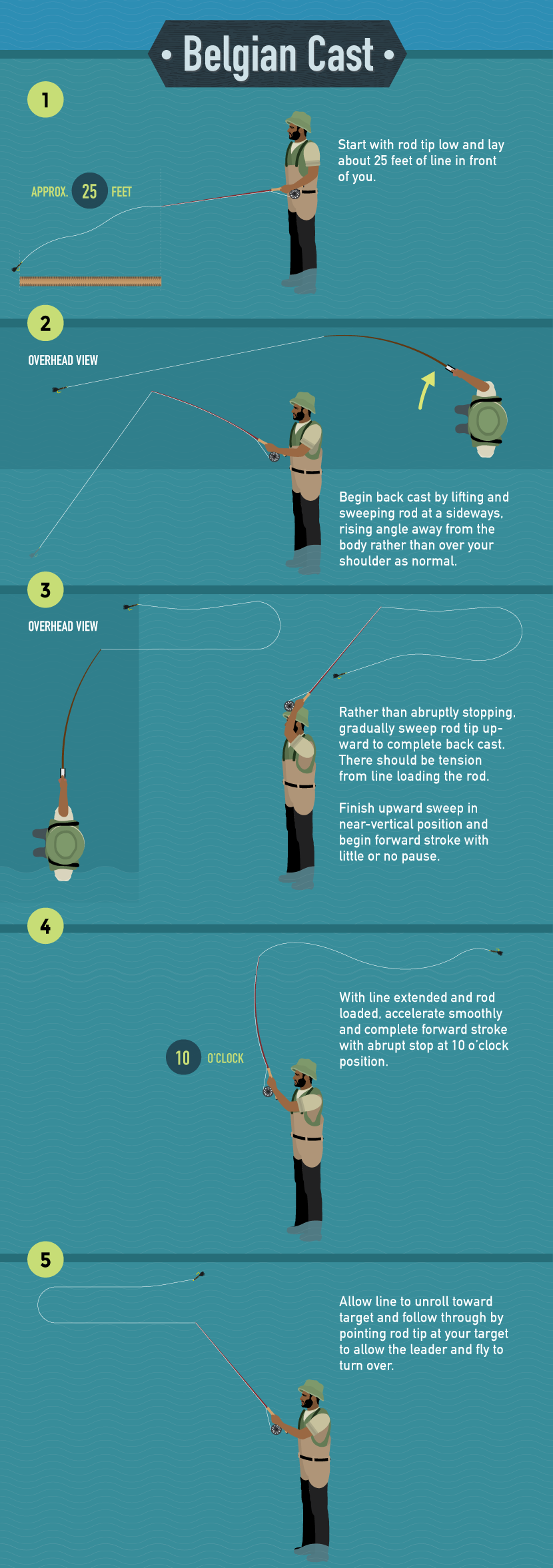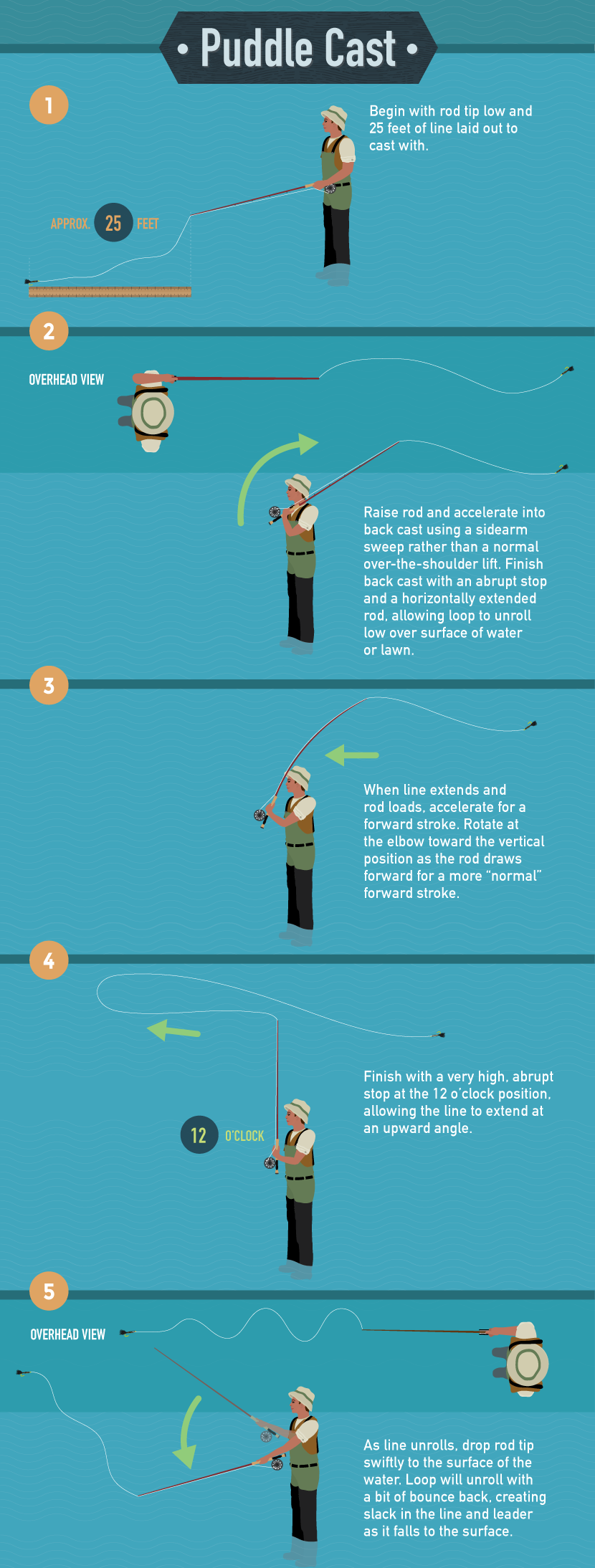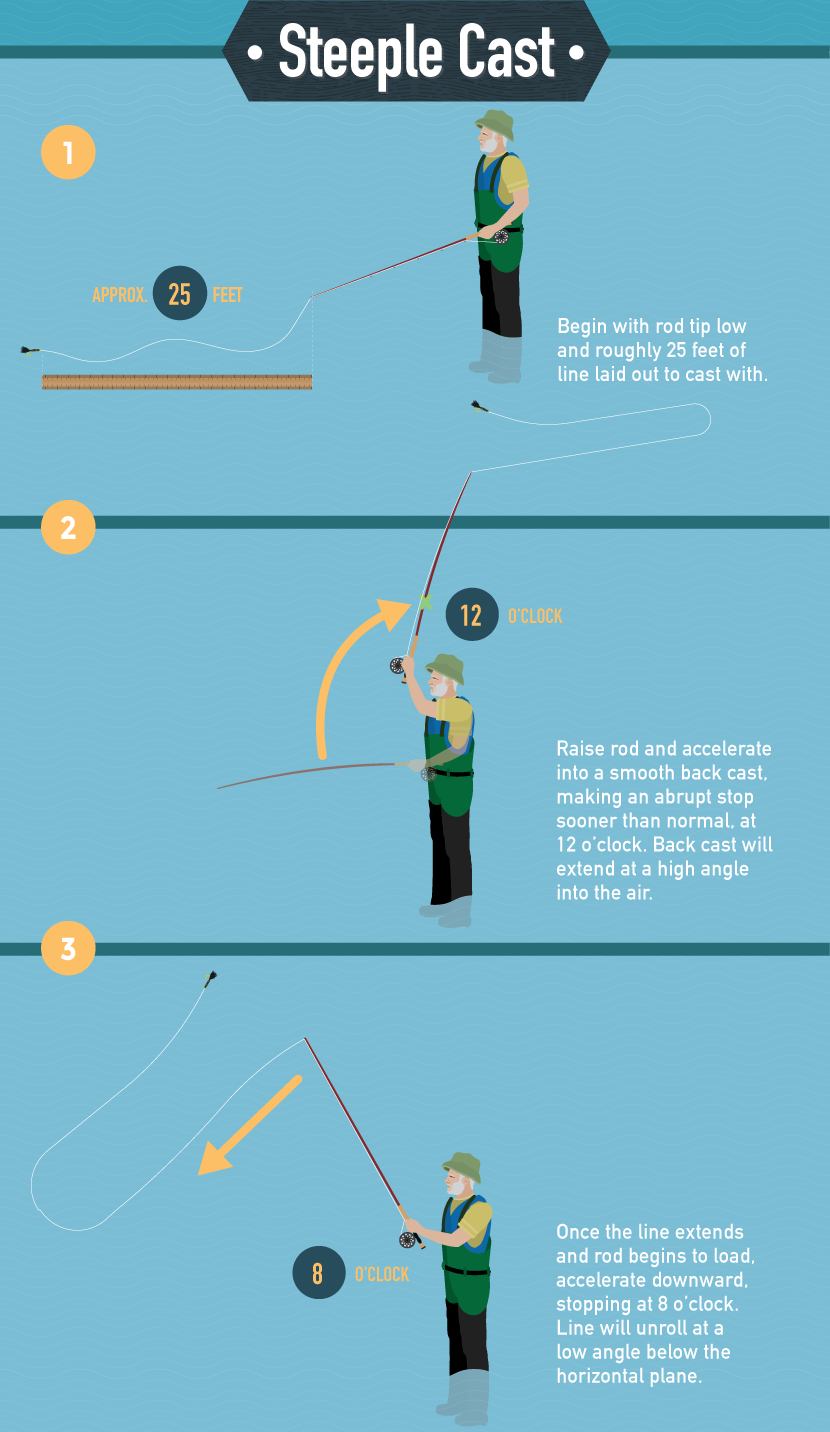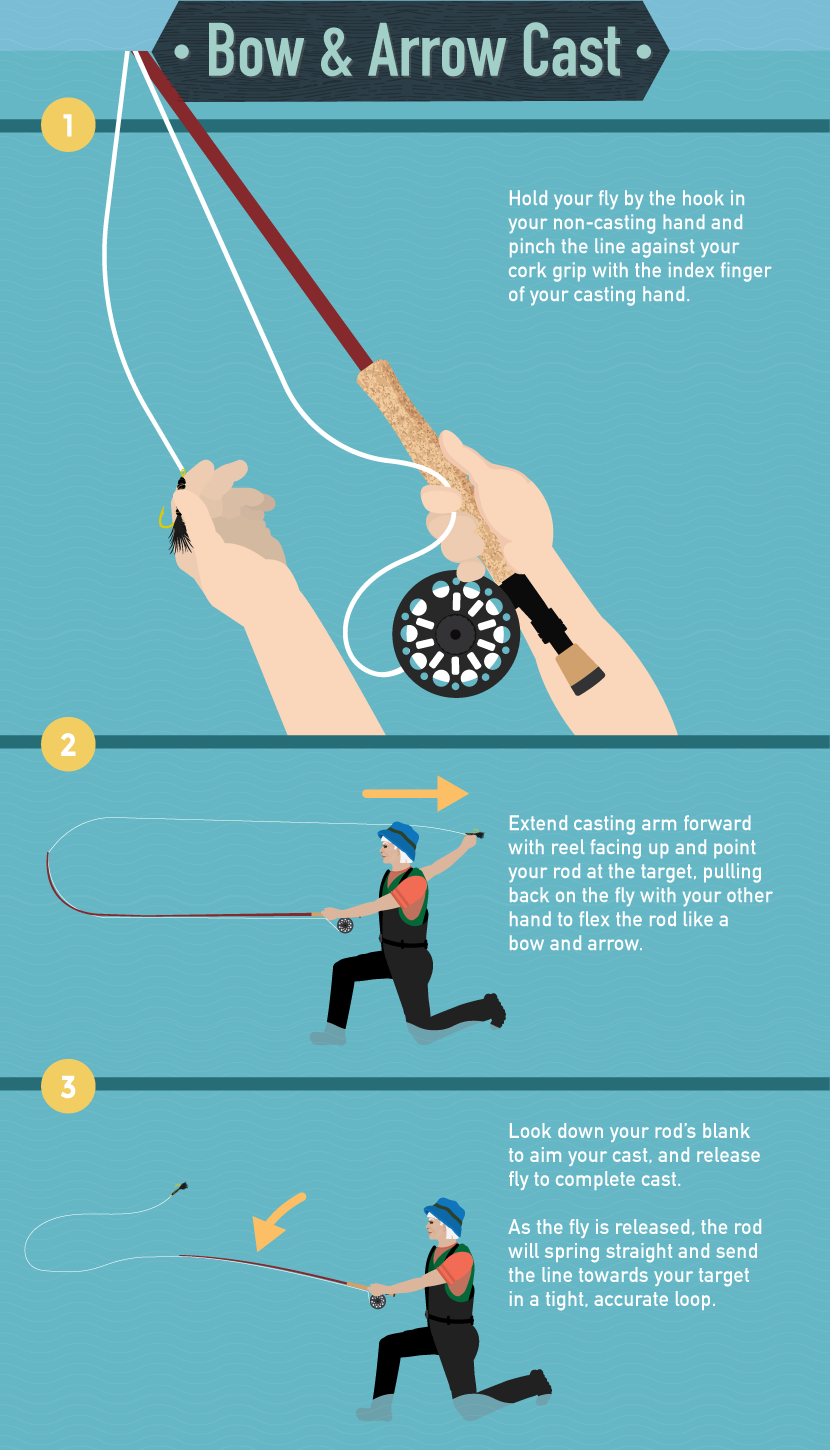Advanced Fly Casting Techniques:
Take Your Fly Fishing to the Next Level With These Casts
Improving your casting skills is one of the best things you can do to take your fly fishing to the next level.
Building a solid foundation of basic techniques is guaranteed to make you a better angler, but there will come a point when you’ll want to add more advanced techniques to your skill set.
You may want to generate more power in order to cast a greater distance or cope with wind. Or maybe you’ve spotted a good trout lie on the opposite bank that’s covered by overhanging brush and requires a special technique to deliver the fly.
There are special casts that will help you make a good presentation in the many different situations you’re bound to encounter while fishing. Here are a few of the most useful techniques to get you started.
Reach Cast
Most beginner and intermediate fly anglers quickly learn the importance of mending to combat drag imparted by the current in a river.
When fishing for wary trout or casting across swift currents, there are certain situations where making a mend in the line before the fly hits the water will give you a better chance at coaxing a strike from the fish.
This is where the reach cast can save the day.
The reach cast is essentially an aerial mend that’s made while the cast unrolls in the air, and it’s an extremely useful cast when executed properly.

The reach cast is actually pretty simple to accomplish: it just takes some practice to coordinate a cast with a mend in one movement.
This cast can be used to create slack line (a mend) in either an upstream or downstream direction, depending on where the rod tip is pointed at the cast’s completion.
With practice, making this cast will become automatic when you’re fishing, and you may wonder how you ever got along without it!
- Start with about 25 feet of line laid straight in front of you and the rod tip low, just like you would for a normal overhead cast.
- Lift the rod and begin your back cast with the usual smooth acceleration, complemented by an abrupt, high stop with the rod at approximately a 1 o’clock position. Pause for a moment to allow the loop to extend behind you.
- When the rod begins to load, make a normal forward acceleration combined with a high stop at the 10 o’clock position.
- Here’s where the reach comes into play. As the loop begins to unroll in front of you, make an arc with the rod tip similar to a mending motion in the desired direction. A good rule of thumb to follow is to make a mend to your right and draw an arc from left to right with the rod tip ending with your palm facing up (for right-handed casters). To make a mend to the left, draw an arc from right to left, ending with your palm facing down. The movement must be timed so you’re repositioning the line as it unrolls in front of you before it lands on the surface of the water.
- After you’ve drawn your desired arc and the line is fully extended, lower the rod tip to allow the leader and fly to turn over.
This cast is great for moments when you have tricky currents to deal with. There are many times when fishermen cast over swift currents to targets in pockets, seams, or eddies where the current is much slower.
By making the mend before the fly touches the water, the fly is drifting and fishing for the maximum amount of time before the current drags it away.
The reach cast is also wonderful for making presentations to visible fish that may be put down by excessive movement or disturbance on the water’s surface caused by mending.

Belgian Cast
When we learn how to cast a fly rod, we’re taught that a proper cast will unroll flat, horizontal to the surface of the water in both the back and forward portions of the cast.
There are times when changing the casting angle or “plane” will give an angler an added advantage when presenting the fly.
The Belgian cast is a perfect example of this, as the caster performs a low, sweeping back cast combined with a standard forward cast.
A true Belgian cast creates a continuous load on the rod, which makes it a great cast for when you’re using heavy flies, sinking lines, split shot, strike indicators, or other paraphernalia to get down deep beneath the surface.
Because the line stays under tension throughout the backward casting stroke, your line and leader stand a lower chance of tangling during the cast.
- Start with the rod tip low and have about 25 feet of line laid out to practice with. If you’re using a sinking line or weighted fly on the water, it may be necessary to roll cast the line to the surface before beginning your cast.
- Begin the back cast by lifting and sweeping the rod at a sideways, rising angle away from your body rather than up over your shoulder like you would with a normal overhead cast.
- Rather than finishing with an abrupt stop, gradually sweep the rod tip upward to complete the back cast. You should feel the tension from the line loading the rod. Your upward sweep should finish with the rod in a near vertical position, ready to begin a normal forward casting stroke. Now, begin the forward stroke with little or no pause.
- With the line extended and the rod loaded, accelerate smoothly for your forward stroke and complete the stroke with an abrupt stop at the 10 o’clock position.
- Allow the line to unroll toward your target and then follow through by pointing the rod tip at your target to allow the leader and fly to turn over.
The Belgian cast is an excellent choice for fishing with nymphs and streamers, in cases where excess weight makes a normal overhead back cast difficult or dangerous.
This is also a wonderful choice for casting with wind at your back. The low back cast allows the line to effectively cut underneath the wind and load the rod for a powerful forward stroke.
Puddle Cast
The puddle cast is another change-of-plane cast involving a low back cast combined with a high forward cast and an abrupt drop of the rod tip.
The goal of this cast is to allow the line and leader to fall with a series of “S” curves or slack loops in the cast.
This cast is extremely effective when presenting the fly on a dead drift to trout that are downstream of the angler’s position.
The slack loops created in the line and leader allow the fly to drift freely downstream to the feeding trout.

- Begin with the rod tip low and have about 25 feet of line laid out to practice with.
- Raise the rod and accelerate into your back cast using a sidearm sweep of the rod rather than a normal, over-the-shoulder lift. You should finish your back cast with an abrupt stop and with the rod extended horizontally, allowing your loop to unroll low over the surface of the water or lawn.
- When the line is extended and the rod begins to load, start accelerating for a forward stroke, and as you draw the rod forward, rotate at the elbow to bring your rod tip to a vertical position for a more “normal” forward stroke.
- Finish with a very high, abrupt stop, with the rod tip not traveling much past the 12 o’clock position. This will allow the line to begin extending at an upward angle.
- As the line unrolls, drop the rod tip swiftly to the surface of the water or lawn. The loop will unroll swiftly with a bit of a “bounce” back, creating slack in the line and leader as it softly falls to the surface.
Use this cast to your advantage when you need to get upstream of wary trout and make a “fly first” presentation so that you don’t spook them with the leader and line.
With some practice, it will become a very effective addition to your skill set.
Steeple Cast
The steeple cast is also a change-of-plane cast, but rather than making a low back cast and a high forward cast,
the angler executes the opposite: a high back cast followed by a sharp, downward forward cast.
This cast is effective in small, brushy streams where bushes, rocks, or tall grasses may limit a traditional back cast.
It is also very helpful for high-sticking in pocket water situations where it’s imperative to place only the fly and not the leader or line on the swirling surface of the water.

- Begin with the rod tip low and have about 25 feet of line laid out to practice with.
- Raise the rod and accelerate smoothly into a normal back cast, but make your abrupt stop sooner than normal, stopping at the vertical 12 o’clock position. The upward motion combined with a high stop will cause your back cast to extend at a high angle into the air rather horizontally, as with the standard back cast.
- Once the line extends and the rod begins to load, accelerate downward, stopping the stroke at a 7 o’clock or 8 o’clock position. This lower-than-normal stop will cause the line to unroll at a low angle below the horizontal plane.
- If this cast is done properly, the fly should touch the water before the leader and line.
Bow and Arrow Cast
The bow and arrow cast is a fun and simple cast that works wonders when you need to put your fly into a tight spot.
Unlike as in most fly fishing casts, the load is generated by the angler holding the fly or leader and pulling the rod tip back like with a bow and arrow.
This cast is best for short distances but is extremely accurate and sometimes the only option when fishing small streams where making a back cast may not be possible.

- Hold your fly by the hook in your non-casting hand and make sure to pinch the line against the cork grip with the index finger of your casting hand. This cast works best with just your leader and 6 to 12 inches of line hanging out of the tip of the rod.
- Extend your casting arm forward with the reel facing up, point your rod at the target, and pull back on the fly with your other hand to flex the rod like a bow and arrow.
- Look down the length of the rod to “aim” your cast, and when you’re ready, release the fly to complete the cast.
- When you release the fly, the rod will spring straight and send the line toward its target in a tight, accurate loop.
Practice this cast on the lawn, and use it whenever you get into a tight spot where you think there might be a fish.
When it comes to improving your casting and angling skills, there’s no substitute for time spent with rod in hand training your muscles and developing a feel for how the rod and line respond to different input.
Get out to the park or a piece of water nearby and give these casts a try. I guarantee you’ll be pleased with the results on your next fly fishing trip!
Embed the article on your site

